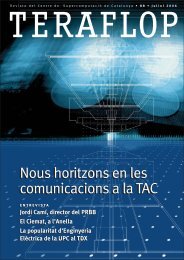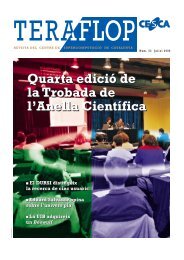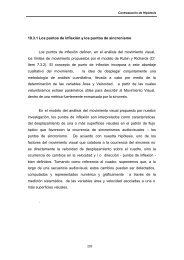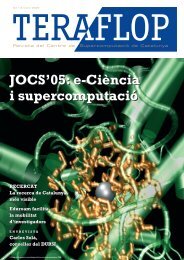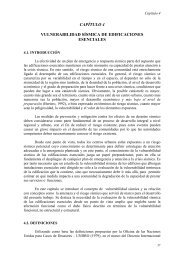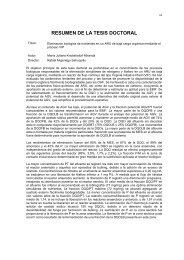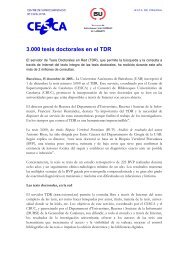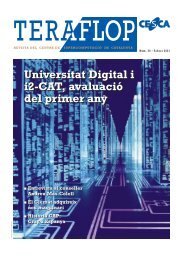Teraflop 73 - Novembre - cesca
Teraflop 73 - Novembre - cesca
Teraflop 73 - Novembre - cesca
You also want an ePaper? Increase the reach of your titles
YUMPU automatically turns print PDFs into web optimized ePapers that Google loves.
The discoveries of fullerenes<br />
and nanotubes, both of which<br />
took place in close succession<br />
in the mid 1980s and early<br />
1990s, have marked the start of scientific<br />
revolution in the fields of physics,<br />
chemistry and materials science, and<br />
have greatly contributed to bringing<br />
nanotechnology to the attention of scientists,<br />
technocrats and even the general<br />
public. Few in the scientific community<br />
had dared to imagine that so<br />
extensively-studied an element as<br />
carbon could still hide secrets of this<br />
calibre. Furthermore, soon after these<br />
discoveries it was realised that these<br />
fascinating novel materials had many<br />
interesting properties, not always present<br />
in other more conventional forms<br />
of carbon, and these properties conferred<br />
to them an immense scope for<br />
technological applications. Today,<br />
there is probably not a single university<br />
web page in the world where you<br />
cannot find a picture of a fullerene or<br />
nanotube lurking somewhere, and<br />
this in itself testifies to the interest<br />
these nanostructures have generated.<br />
Fullerenes are closed cage-like<br />
structures which contain hexagonal<br />
rings of carbon, as found in graphite,<br />
but in order for these structures to be<br />
closed, they must also contain exactly<br />
twelve pentagons, which curve the<br />
structure so that it folds and closes on<br />
itself. C 60, the most famous of the<br />
fullerenes, looks exactly like a football,<br />
only it has a diameter of less than<br />
1 nm (10 -9 metres). Each of the twelve<br />
pentagons is surrounded by five<br />
hexagons, and there are twenty hexagons<br />
in total. The fullerenes were discovered<br />
by chance in 1985, when a<br />
team of British and American scientists<br />
were trying hard to synthesise<br />
chains of carbon atoms, which they<br />
thought could exist in space, and<br />
Fullerenes, Nanotubes and Related<br />
Nanostructures:<br />
A Paradigm of Nanotechnology<br />
Eduardo Hernández<br />
Institut de Ciència de Materials de Barcelona<br />
CSIC<br />
The structure of the Buckminsterfullerene<br />
isomer of C60. could be responsible for certain unaccounted-for<br />
spectral lines in the radiation<br />
received in Earth. When<br />
analysing the product of their synthesis<br />
experiments in a mass spectrometer<br />
they found that many carbon clusters<br />
of different sizes were obtained,<br />
but for clusters with sizes larger than<br />
20-30, amazingly, all clusters had an<br />
even number of carbon atoms, and<br />
the cluster of size 60 seemed to be<br />
specially stable. By appropriately tuning<br />
the conditions of their experiments<br />
they were able to obtain essentially<br />
C 60 alone, which again confirms<br />
the special stability of this cluster<br />
size. It was when trying to understand<br />
why this size was so favoured, that<br />
these scientists came up with the proposal<br />
of the C 60 structure known as<br />
Buckminsterfullerene, in honour of<br />
Buckminster Fuller, the famous American<br />
architect and mathematician. The<br />
Buckminsterfullerene structure of C 60<br />
was confirmed some years later, by a<br />
German research team, which was<br />
able to synthesise C 60 in sufficient<br />
quantities as to form fullerite, a molecular<br />
solid of C 60 clusters, and identify<br />
the structure using crystallographic<br />
techniques. In 1996 Prof. Harry Kroto,<br />
from Sussex University in England,<br />
and Profs. Richard Smalley and<br />
Robert Curl, from Rice University in<br />
the United States, were awarded the<br />
Nobel Prize in Chemistry for the role<br />
they played in the discovery of C 60<br />
and the fullerenes.<br />
Fullerenes immediately attracted<br />
a great deal of attention to themselves,<br />
and many scientific teams around the<br />
world started performing experiments<br />
or conducting theoretical studies to<br />
better understand and characterise<br />
these novel structures. And it was in<br />
this way that fullerenes lead to the subsequent<br />
discovery (or re-discovery, in<br />
fact) of carbon nanotubes. These were<br />
found in the carbon soot that resulted<br />
from a fullerene synthesis experiment,<br />
when this was observed in a transmission<br />
electron microscope by the<br />
Japanese scientist Sumio Iijima, although<br />
it appears that nanotubes had<br />
previously been observed as early as<br />
in 1975 by another Japanese scientist<br />
working in France, Morinobu Endo.<br />
Nanotubes are tubular structures,<br />
made of seamlessly rolled-up graphite<br />
layers (graphene). They come in two<br />
types: multi-wall nanotubes, consisting<br />
of several graphene layers, which can<br />
be several nanometers in diameter, or<br />
single-wall, with a diameter typically<br />
between 1 and 2 nm (though smaller<br />
and larger diameters have also been<br />
observed). In either case their length<br />
is much larger than their diameter, so<br />
they are essentially one-dimensional<br />
structures. Nanotubes were yet another<br />
surprise that carbon kept hidden<br />
(or at least not fully disclosed), although<br />
now it is known that nanotubes<br />
can be made of other materials forming<br />
layered structures similar to<br />
graphite, such as BN, WS 2,MoS2, Bi,<br />
etc. However, it is still the case that carbon<br />
nanotubes, especially single-wall






